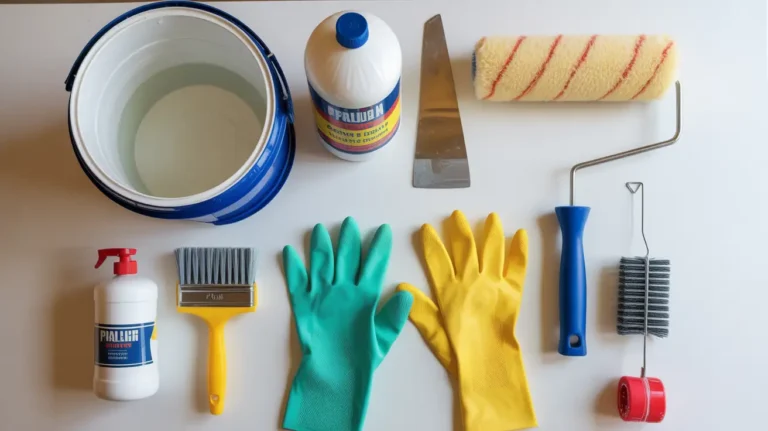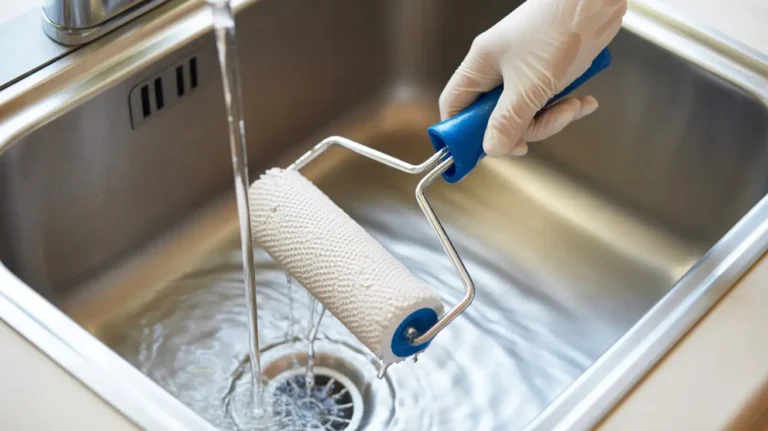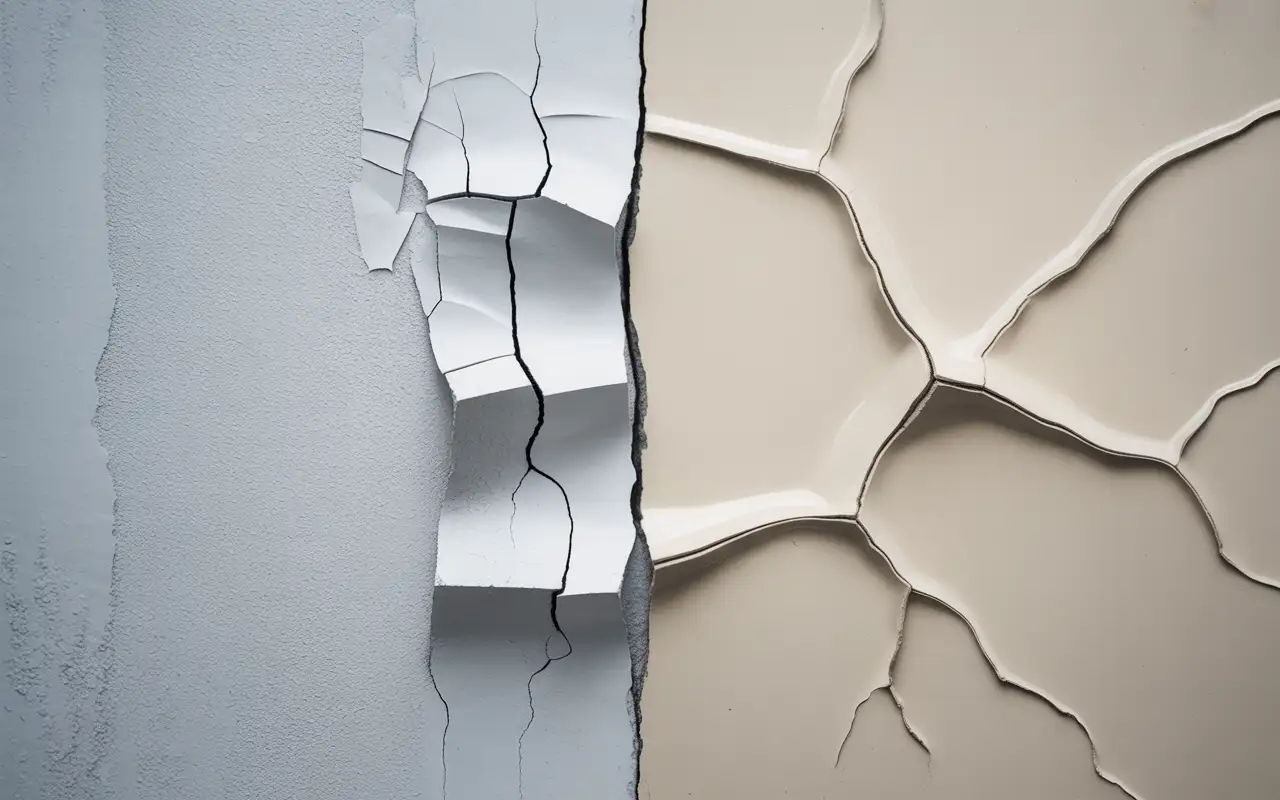Painting a room or refreshing your cabinets is rewarding, but cleanup often feels like a chore. Learning how to clean paint rollers correctly is essential for any project. Clean rollers save you money because you can reuse them, and they guarantee a smooth, flawless finish on your next job.
This in-depth guide is based on years of professional experience. We will share proven methods and natural ways to clean paint roller covers, ensuring they last for multiple uses. We will also cover the real cost of cleaning versus replacement, so you make the smartest choice for your home.
Table of Contents
ToggleThe Importance of Cleaning Paint Rollers
Dirty rollers ruin your next paint job. Old paint debris creates bumps and streaks on fresh walls. Paint that dries in the roller fibers makes them stiff and useless.
Regular cleaning extends the life of your painting tools. A $12 roller cover that you clean after each use can last through an entire house renovation. Compare that to buying new covers every time you’d spend $60-120 on a full home project.
Clean tools also work better. Fresh roller fibers hold more paint and spread it evenly. You’ll finish faster with better results.
When to Replace Instead of Clean:
- Fibers are shedding or falling apart
- Paint won’t come out after 15 minutes of washing
- The roller cover is flattened or misshapen
- You see dried paint chunks stuck in the nap
For oil-based paint projects, many painters buy cheap roller covers ($3-5) and toss them. The cost of mineral spirits ($12-15 per gallon) plus disposal fees makes cleaning less practical.
What You'll Need

For Water-Based Paint:
- 5-gallon bucket
- Dish soap
- Putty knife or 5-in-1 tool
- Wire brush
- Rubber gloves
- Old newspapers
- Hot water (140-160°F works best)
For Oil-Based Paint:
- Mineral spirits ($12-15 per gallon)
- Disposable container
- Putty knife
- Rubber gloves
- Safety glasses
- Old rags
- Bucket for final wash
Storage Supplies:
- Plastic wrap or plastic bags
- Clean paper towels
- Dry storage space
The total cost for cleaning supplies runs about $15-20. These materials handle dozens of cleaning sessions.
How to Clean Paint Rollers: Step-by-Step Process

Cleaning Water-Based Paint (Latex, Acrylic)
Step 1: Remove Excess Paint Immediately
Time matters with paint roller cleaning. Latex paint dries in 30-60 minutes, so start cleaning right away.
Hold your roller over the paint tray. Use a putty knife to scrape excess paint back into the can. Work from top to bottom in smooth strokes. This recovers about 2-3 ounces of paint per roller.
Roll the remaining paint onto old newspapers until the roller stops releasing color. This step alone removes 70-80% of the paint.
Step 2: Separate and Clean the Roller Frame
Pull the roller cover off the frame. Don’t skip cleaning the frame; dried paint here ruins the spinning action.
Fill a bucket with hot water and add 2-3 drops of dish soap. Too much soap creates foam that makes rinsing harder.
Scrub the roller cage and handle with a wire brush. Pay attention to the end caps where paint collects. Rinse under running water and set aside to dry.
Step 3: Wash the Roller Cover
Submerge the roller in your bucket of warm water and soap. Use your gloved hands to massage the paint out of the fibers. Work from one end to the other in a squeezing motion.
The water will turn cloudy with paint. That’s normal. Keep working the roller for 3-5 minutes. You’ll feel the fibers soften as paint releases.
For stubborn spots, hold the roller under running water while squeezing. The pressure helps push paint out of deep fibers.
Step 4: Rinse the Roller Thoroughly
Rinse under clean running water for 2-3 minutes. Squeeze the roller as water flows through it. Keep rinsing until the water runs completely clear.
Check for paint streaks by squeezing the roller over white paper. If you see any color, rinse more.
Step 5: Remove Excess Water
Shake the roller vigorously to remove excess water. Do this outside or in a tub water will spray everywhere.
Spin the roller on its frame 10-15 times. This centrifugal force pulls water out of the core.
Step 6: Dry the Roller Properly
Never lay a wet roller flat. This flattens the fibers and creates lines in your next paint job.
Stand the roller upright on one end, or hang it from a wire. Air circulation is key, drying takes 24-48 hours depending on humidity.
Speed up drying by placing the roller near a fan (not a heater). Direct heat can melt synthetic fibers.
Step 7: Clean the Paint Tray
Scrape dried paint from the tray edges with your putty knife. Wash with hot soapy water and a scrub brush.
For plastic trays, you can let thin latex paint dry completely, then peel it off in one sheet. This works about 60% of the time.
Metal trays need immediate washing. Dried paint is much harder to remove from metal.
Cleaning Oil-Based Paint
Oil-based paint requires solvents. Water won’t work because oil and water don’t mix.
Safety First:
- Work in a ventilated area
- Wear rubber gloves and safety glasses
- Keep mineral spirits away from flames
Step 1: Remove Excess Paint
Scrape excess paint back into the can using a putty knife. This saves expensive mineral spirits.
Step 2: First Solvent Bath
Pour mineral spirits into a disposable container just enough to submerge the roller. You’ll need about 1-2 cups.
Work the roller in the solvent for 5-8 minutes. Squeeze and massage to release paint. The liquid will turn cloudy with paint.
Remove the roller and squeeze out the dirty solvent into a separate container for disposal.
Step 3: Second Solvent Rinse
Rinse the roller in fresh mineral spirits. This removes the last paint residue. Use about 1/2 cup for this step.
Step 4: Soap and Water Finish
Fill a bucket with warm water and dish soap. Give the roller a final wash to remove solvent smell and residue.
Rinse well under running water. The roller should feel clean and soft.
Step 5: Dry and Store
Remove excess water and dry upright. The solvent smell will fade in 24-48 hours.
Cost Reality Check: You’ll use $3-5 worth of mineral spirits per roller. Add disposal costs if your area requires special handling. For a $4 disposable roller cover, cleaning doesn’t make economic sense. Save the deep cleaning for premium roller covers ($12-20).
Quick Clean for Short Breaks
Taking a lunch break or stopping for the day? Don’t wash the roller yet.
Wrap it tightly in plastic wrap or slip it into a plastic bag. Squeeze out air and seal. Store in your refrigerator this sounds odd but works perfectly.
The cool temperature keeps latex paint wet for 2-3 days. Let the roller warm to room temperature (30-60 minutes) before using again.
This trick saves water and time between coats.
How to Handle Dried Paint
For minor areas of dried paint on a roller, try soaking the roller cover in warm water with fabric softener for an hour before following the cleaning steps above. For oil-based paint with significant dried areas, it may not be possible to fully restore the roller. In this case, disposing of the cover and using a new one is often the better and safer choice. This helps guarantee your quality of work.
Troubleshooting Common Problems
Dried Paint in the Roller: If paint dried before you cleaned, try this:
- Soak water-based paint in hot water (160°F) for 2 hours
- Add 1/4 cup white vinegar to help break down latex
- Work the roller every 30 minutes
- Success rate: about 30-40%
For oil-based dried paint, the roller is usually ruined. The solvent needed plus time invested exceeds replacement cost.
- Roller Smells Like Paint: After cleaning, smells linger in foam rollers. Soak in a vinegar-water solution (1:3 ratio) for 30 minutes, then rinse. This removes 80-90% of odors.
- Flattened Fibers: Once fibers flatten from improper drying, they won’t recover. The roller will leave lines. Replace it.
- Shedding Fibers: This happens with worn rollers or cheap covers. No fix exists, the roller has reached the end of life.
How to Store a Paint Roller
Proper storage is as vital as cleaning. When you clean paint roller covers well, you want to protect them until the next use.
- Short-Term Storage (Between Coats or Days): If you plan to paint again within a few days using the same color, you do not need to clean the roller. Simply keep the paint rollers wet. Wrap the roller cover tightly in plastic wrap, aluminum foil, or a sealable plastic bag. Place it in the refrigerator. This keeps the paint from drying out.
- Long-Term Storage (Project is Finished): Once the roller is clean and the water has run clear, stand the roller cover upright on a piece of scrap cardboard or newspaper. Never lay it flat, as this will crush the nap. Allow it to air dry completely. Once dry, wrap the roller in a clean plastic bag to keep it dust-free until the next use. Properly cleaned and stored, you can reuse paint rollers many times. Can you reuse paint rollers? Yes, if you follow these steps.
Roller Type Cleaning Differences
Different roller materials need slight adjustments:
- Microfiber Rollers ($10-15): These hold lots of paint, so spend extra time squeezing during washing. They’re worth the cleaning effort and very durable.
- Foam Rollers ($3-6): Hard to clean thoroughly. Foam traps paint deep inside. Best to dispose after use unless it’s a premium foam roller.
- Lambswool Rollers ($15-25): Natural fibers need gentle handling. Use cooler water (110-120°F) to avoid damaging the wool. Air dry only never uses heat.
- Synthetic Blend Rollers ($8-12): Most common type. Handle hot water well. Clean easily and last 6-10 uses.
Cost Comparison: Clean vs. Replace
Basic Scenario (Interior Room):
- 4 roller covers at $4 each = $16
- OR 1 quality roller at $12 + cleaning supplies = $12
- Savings: $4 per room
Full House Project (10 rooms):
- 40 disposable rollers = $160
- OR 4 quality rollers cleaned 10 times = $48 + $15 supplies = $63
- Savings: $97
For professional painters doing 50+ jobs yearly, cleaning quality rollers saves $500-800 annually.
SD Custom Painting Company Knows Clean Tools Make Cleaner Walls
At San Diego Custom Painting, we know that the quality of our tools directly impacts the quality of our finishes. Whether we are providing our expert exterior painting services in San Diego, transforming a home with beautiful interior painting, or performing detailed cabinet painting, immaculate tools are a non-negotiable part of our process.
Our dedication to meticulous cleanup and tool maintenance ensures that every project we undertake from preparing the surface to the final brushstroke meets the highest professional standards. A clean roller means no stray fibers, no dried paint clumps, and a consistently smooth application that delivers flawless results every time. Trust a company that values the details.
FAQs About Cleaning Paint Rollers
What is the best way to clean a paint roller with latex paint?
The best way to clean a paint roller cover used with latex (water-based) paint is to first scrape excess paint off, then submerge the roller in a bucket of warm water and a little dish soap. Massage the nap, and then rinse the roller under clean, running water until the water is completely clear.
Can you reuse paint rollers?
Yes, you absolutely can reuse paint rollers. High-quality roller covers can be reused many times if they are cleaned immediately after use and dried thoroughly before storage. This is true for both water-based and oil-based paints, provided the correct cleaning agent is used.
How do I clean a paint roller that has dried oil-based paint on it?
To clean a roller with dried oil-based paint, you will need a strong solvent like mineral spirits. First, soak the roller cover in the solvent to soften the paint. Then, wearing gloves, work the paint out of the nap. A final wash with warm, soapy water removes the solvent residue. If the paint is very hard and deep in the roller nap, replacement may be necessary.
What tools can help me clean paint roller covers faster?
A putty knife or 5-in-1 tool is essential for scraping off the bulk of the paint. A wire roller cleaner is a useful tool specifically designed to help agitate and strip paint from the roller nap when under running water. A paint roller cleaner tool significantly speeds up the process.
Should I use cold or warm water to wash paint roller covers?
Always use warm water when cleaning latex or water-based paint from your roller covering. Warm water helps to soften the paint and release it from the roller fibers more effectively than cold water.





